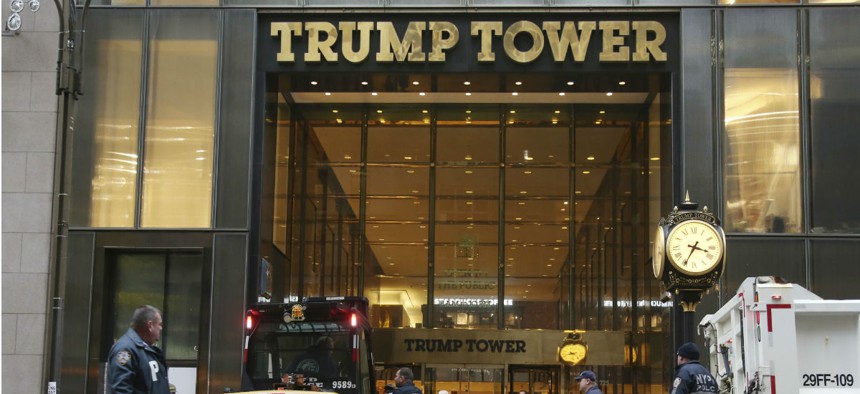
Seth Wenig/AP
Pay and Benefits Under Trump, Best Cities for Vets, and More
A weekly roundup of pay and benefits news.
It’s too soon to tell what effect the 2016 presidential and congressional elections will have on federal pay and benefits. But based on what we’ve heard and seen from President-Elect Donald Trump and many Republican lawmakers so far, we could be in for some changes.
Trump himself hasn’t specifically mentioned any pay or benefits proposals affecting federal employees, but he has talked about a governmentwide hiring freeze and shrinking the workforce through attrition. (Though he also has expressed support for beefing up personnel at the Homeland Security Department.) Vice President-Elect Mike Pence has consistently supported limiting the size of the federal workforce and moving government employees to a pay-for-performance system.
And there’s been no shortage of congressional proposals over the past several years that have targeted federal workers’ pay, bonuses, pensions and job security. Some of them – including increasing the amount new federal employees contribute to their retirement annuity and making it easier to fire career senior executives at the Veterans Affairs Department – have become law. We could see similar ideas emerge, and succeed, more frequently in a Republican-controlled government. We’ll be watching and reporting on it all in the months and years to come. Stay tuned.
October was a rough month for both presidential candidates, and as it turns out, for the federal retirement claims backlog. After falling by more than 1,000 applications in September, the backlog was up again in October – from 15,146 applications to 16,677 claims by the end of last month. The Office of Personnel Management received slightly more claims in October than in September, but processed 2,339 fewer applications.
OPM processed 55 percent of cases in 60 days or less last month, down from 77 percent in September. The agency has managed to chip away at the average number of days it took to process cases that took longer than two months: In October, it was 91 days, down from 100 days in September.
The retirement claims backlog typically spikes in January and February and then gradually falls throughout the year. Clearing up the pile of outstanding claims has been an ongoing struggle for OPM and a constant source of frustration for federal retirees.
Are you a veteran looking for the best cities in America to live in when it comes to housing affordability and proximity to VA health care facilities? All of them are out West, according to a new report from WalletHub, a personal finance website. Scottsdale, Ariz., is the number-one choice, according to WalletHub. Cities that are considered favorable to veterans included Laredo, Texas; Irvine, Calif.; Plano, Texas; and Austin, Texas. The report compares 100 of the most populated U.S. cities across 21 metrics – including availability of jobs, poverty rates among the vet population, and quality of life. Where are the worst cities to live, according to WalletHub? Detroit, Mich.; Newark, N.J.; Cleveland, Ohio; Memphis, Tenn.; and Boston, Mass., among others. The website also rated the best military credit cards in 2016, which included the USAA Cashback Rewards Plus American Express Card and the PenFed Defender Visa Signature Card.
Speaking of veterans, the percentage of disabled post-9/11 vets with health insurance through the VA has increased 11 percent over the last few years, despite the department’s well-publicized management problems and the 2014 patient wait-times scandal, according to a new survey.
Seventy-one percent of injured Iraq and Afghanistan veterans said they had VA health care coverage in 2016, compared to 66 percent in 2015, and 59 percent in 2014, the latest survey from the Wounded Warrior Project found. Of those respondents, or “alumni” as the WPP calls them, 68 percent used VA health care as their primary health care provider. The percentage of alumni with two or more types of health care insurance is also growing, jumping from 45 percent in 2015 to 48 percent in 2016. The 2014 Veterans’ Access, Choice, and Accountability Act expanded health insurance options for many vets, allowing them to use private health care providers in cases where VA could not meet their needs.







